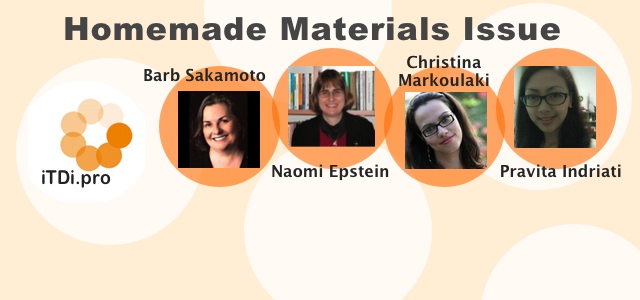Reduce! Reuse! Recycle! – Barbara Hoskins Sakamoto

Course Director
Turns out, the same principles that are good for Mother Earth are also an excellent way to teach. I don’t mean simply giving milk cartons, bottle caps, or plastic bottles a new life as classroom resources, although anything that keeps items out of landfills has got to be a good thing. I mean that we should apply these three principles to all that we do in class.
Reduce the amount of new language in lessons
Reuse language, games and activities
Recycle familiar language with new
Reduce! It isn’t how much you teach, it’s how much students can do with the language they learn.
In workshops, I often meet teachers who are pressured by administrators (who are pressured by parents) to teach as much as possible in each class, to move as quickly as possible through each coursebook. The classes in which I see students making the greatest progress are those in which the teachers introduce relatively little new language in each class, recycle previously learned language in order to introduce the new, and then spend the majority of class time reusing both new and familiar language in new contexts.
There are certainly times when you will choose to throw students into the deep end of the language pool – when asking them to work at understanding the gist of a listening or reading task, for example. But, it should be a choice that works toward your lesson goals, not the standard approach. If you need to spend most of your class explaining the language on your coursebook page, then students are unlikely to remember much for the next class, and you end up teaching the same things over, and over, and over again without much feeling of progress.
Reuse! Once students have learned something, you can re-use without having to re-teach
Once students have learned new language, they ought to be able to use it (although they may need to be reminded that they do already know the language). The increases the amount of time available for practice, and learners, especially young learners, need to use language repeatedly, in new contexts, in order to really “own” it. The same is true of activities. If you repurpose a game students are already familiar with, your students can spend more time playing with language and less time learning the rules.

My students enjoy a game with cubes made out of recycled milk cartons. They first learn to play in kindergarten, and because the game becomes more sophisticated as their language grows, it continues to be a favorite throughout elementary and even secondary school. We begin with three cubes for phonics practice, with all six vowels and 12 consonants of their choosing. A turn consists of three chances to toss the cubes, the goal being to form a word. After each toss, students can keep any of the letters rolled, so if they’ve rolled an A and a T, for example, they might keep those letters and roll the final cube, hoping for a B, C, or H. If students make a word they get a point. If they haven’t made a word after three tosses, the next student takes a turn.
When students begin working on word order in sentences, and collocations with verbs, vowels are replaced with verbs, and students now have three tosses to form a sentence. Laughing at sentences like I am cake (and not accepting them as point worthy sentences) means that students are deepening their understanding of language and how it works.
When students are ready for longer, more complicated sentences, we increase the number of cubes to five and work with a mix of nouns, adjectives, verbs, adverbs, and the conjunction and. Students make a list of words that fit each of these categories (searching through their coursebook, browsing through other games and picture cards, and asking for translations). From those, they choose which words to include in their game and write them on the cube sides. My students, at least, prefer the words that have the greatest potential to make silly sentences. They have the same three tosses, but now the goal is to make a sentence that is exactly five words long. While having a lot of fun, students are also discovering that there is more than one correct way to form a sentence, depending on the luck of the toss: Funny rabbits and elephants dance, Funny and furry elephants dance, Funny rabbits dance and sing. They also discover the value of conjunctions more clearly than I could probably explain otherwise.
Recycle! Students can use what they know to figure out what they don’t
There’s no way we will ever be able to teach our students everything they need to know of the English language, so let’s instead teach them how to use what they do know to figure out what they don’t. One of the easiest ways to accomplish this is to introduce new language in the context of familiar. Another way of looking at this is to make sure you maximize the value of any language your students spend the time learning. Here’s one simple example of how teachers mixing familiar and new language can actually help students learn more by teaching less in each lesson.
| It’s green. | |
| It’s windy. | Familiar pattern, new adjectives |
| It’s sunny today. Brenda is eating green grapes. | Familiar language, new context (reading) |
| It was sunny yesterday. | Familiar adjectives, new pattern |
| It’s going to be cool. | Familiar adjectives, new pattern |
| The dolphin was amazing. | Familiar pattern, new adjectives. |
A simple guideline is to teach one new thing (new pattern or new vocabulary, but not both) in each lesson, or for longer lessons or older students, in each section of a lesson. Reducing the amount of time spent on introducing new language creates more time for students to use language – to use it in games and activities that provide the repetition necessary for memory, to add it to their language repertoire in order to talk about new things, to learn to read what they can say and understand, to use language they can read to write about their own unique lives and experiences, and to use language to connect with other students in order to share their own and learn about others’ lives and experiences.
By making efforts to reduce the new language load, to reuse both language and resources, to recycle language in ways that support learning we can make the most effective use of limited class time and set our students on an empowering course to becoming language users rather than just language learners.
For more reading:
Lexical Scaffolding in Immersion Class Discourse (PDF)
Scaffolding English Language Learner’s Reading Performance
Connect with Barb, Naomi, Christina, Pravita and other iTDi Associates, Mentors, and Faculty by joining iTDi Community. Sign Up For A Free iTDi Account to create your profile and get immediate access to our social forums and trial lessons from our English For Teachers and Teacher Development courses.
























